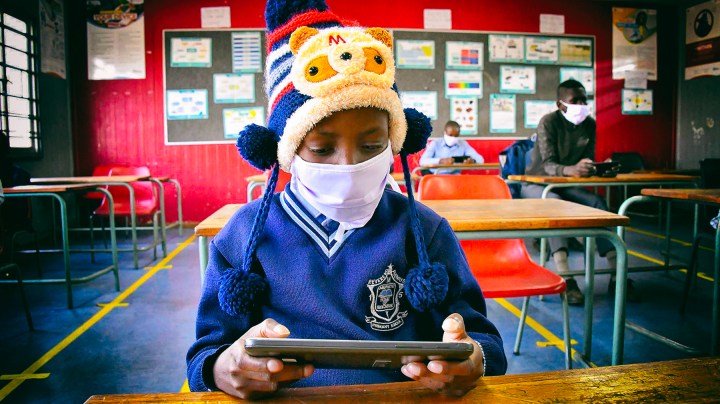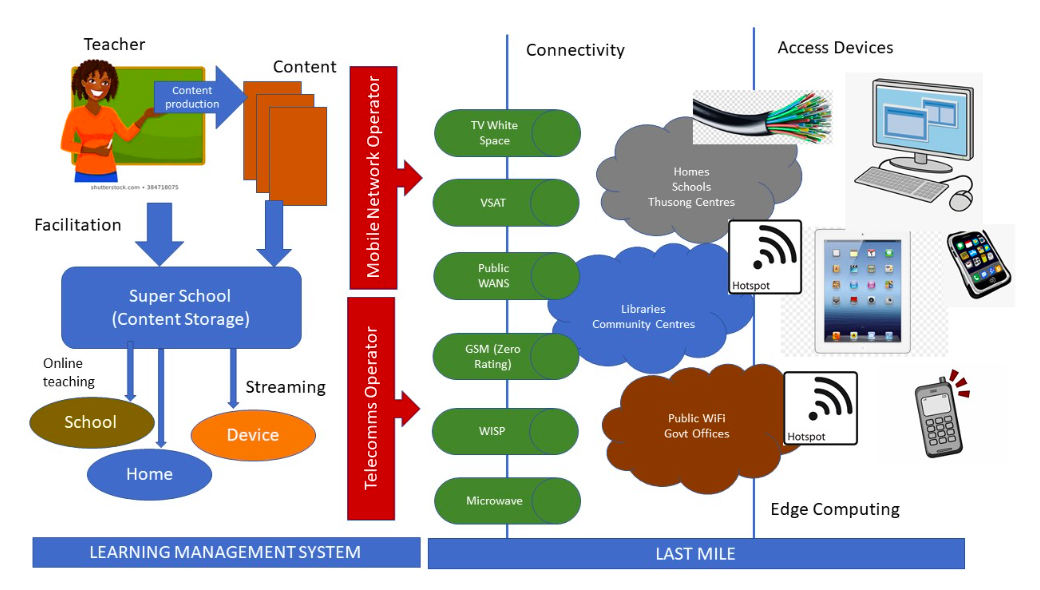OP-ED
SA Education: A national reset is needed and mass internet access is the only way forward

There is a huge digital divide in South Africa that has had a significant impact on education during the pandemic. The adverse effects of the divide are likely to remain a factor in education for the foreseeable future. We need a reset.
In 2015, all United Nations Member States adopted the “Sustainable Development Goals” (SDGs) as “a universal call to action to end poverty, protect the planet and ensure that all people enjoy peace and prosperity by 2030”. Many countries, including South Africa, have set targets for each of the 17 SDGs. Goal 4 (referred to as SDG4) deals with quality education.
In summary, it says, “Achieving inclusive and quality education for all reaffirms the belief that education is one of the most powerful and proven vehicles for sustainable development. This goal ensures that all girls and boys complete free primary and secondary schooling by 2030. It also aims to provide equal access to affordable vocational training, to eliminate gender and wealth disparities, and achieve universal access to a quality higher education.”
In spite of South Africa having made commitments under SDG4, our education system remains in a very poor state. In February 2020, Amnesty International issued a report titled, “Broken and Unequal: The State of Education in South Africa”, which comes to the conclusion that “The South African education system, characterised by crumbling infrastructure, overcrowded classrooms and relatively poor educational outcomes, is perpetuating inequality and as a result failing too many of its children, with the poor hardest hit.”
Against this backdrop, South Africa and the world were impacted by the Covid-19 pandemic in March 2020. It is still too soon to objectively assess the long-term effects this crisis will have on South Africa’s already unequal and shaky education system, but all authorities agree that it will have profoundly negative consequences.
At the start of the national lockdown in March, all South African educational sites were closed. School teachers tried, with varying levels of success, to “go digital”. A great deal depended on families having adequate connectivity and suitable devices at home. Parents also needed to support their children’s learning activities.
Universities and other tertiary educational institutions made bold efforts to keep their academic programmes running, using easily accessible platforms such as Zoom and Teams. Some institutions were able to negotiate zero-rated access and data-bundle deals with mobile network operators (MNOs) on behalf of their students. Some even arranged for laptops to be couriered to students.
While all of these efforts were impressive and laudable, they also shone a spotlight on one inescapable truth: there is a huge digital divide in South African society that has had a significant impact on education during the pandemic. The adverse effects of the digital divide are likely to remain a factor in South African education for the foreseeable future.
This article does not attempt to look at all of the many challenges faced by education amid the current health emergency, and beyond. It focuses on digital connectivity and access, and in particular “the last mile”.
Connectivity and access are the key issues
The General Household Survey, conducted by StatsSA in 2016, found that just under 60% of South Africans had access to the internet. More than half of these connected to the internet via a mobile device, while only 9.5% had a connection at home. In Gauteng and the Western Cape, about 70% of people have internet connections, while in Limpopo this number was 42%, with only 1.6% of people connected at home. There was also a huge gap between metropolitan and rural areas in terms of internet access.
It was into this hugely unequal digital landscape that learners and students were dispatched to deal with eLearning when the government closed all schools and universities as part of the declaration of a State of Disaster. Even those who had access to the internet struggled with connectivity and the cost of data. Other challenges were access to suitable devices and a lack of skills required to learn and teach in a digital world.
The ability of children and students to learn from home has created a large gap.
A bold strategy for finding solutions – a national reset
The Covid-19 pandemic is not just another bump in the road that we will soon overcome. It has triggered a crisis that calls for bold and visionary solutions.
We believe that the situation we are in calls for a national drive to “Bring Fast and Affordable Connectivity to Every South African”. A similar initiative was launched by Ian McRae who, in 1988 as CEO of Eskom, launched a national project to bring “Electricity to All”. Few people appreciate just how important, ambitious and developmental this project was. South Africa’s rate of electrification rose from less than 35% to over 80% over 12 years. We need to now undertake a similar project with the focus on digital access and connectivity.
There are several international examples from which South Africa might draw inspiration. One of these is Vietnam, where the government’s policy to grow the digital economy has led to a growth in affordable, high-speed internet access from close to zero in 2000, to 64% in 2020. Vietnam’s government is now working “to get the majority of people connected to 4G and, in the future, 5G mobile networks and further expand broadband fibre-optic networks, particularly for businesses, schools, and large institutions”.
This strategy to build the digital economy, based on growing internet access throughout the country, has already shown huge social and economic dividends.

Subsidise cost of connectivity to learners, schools and educators
The focus of this article is on the elimination of the “digital divide” as it affects education in South Africa. To be most effective, digitally based education solutions are totally dependent on high-speed broadband to the home and to schools. If this is to be achieved, the government will be required to fund initiatives to roll out fibre to all schools. Since this will take some time, interim wireless and satellite solutions will have to be implemented.
Connectivity must be made available to all learners as soon as possible to avoid the danger that certain segments of our population will be left behind because they do not have or cannot afford access to connectivity. We need to narrow and eliminate the “digital divide” in education as a national priority.
There are two critical steps. First, there is a need to extend and reinforce the backbone network to reach unconnected areas of the country, particularly rural areas. Second, there is the key requirement to deal rapidly with the “last mile”, i.e. connecting schools and homes to this backbone.
Apart from laying fibre, improving the backbone network will require wireless networking solutions such as microwave links, where fibre is not feasible.
The “last mile” will need to be addressed in phases. Rolling out “fibre to the home” (FTTH) is the ultimate objective. In the short term, however, technologies such as “Very-Small-Aperture Terminal Satellite” (VSAT), Public Wi-Fi and “TV White Space” (TVWS) are some of the solutions that can be implemented as appropriate. This will ensure that learning from home can be enabled, especially for rural communities and lower-income urban communities who cannot afford commercial broadband offerings.
Other issues that will need urgent attention are the cost of data and access to devices. During Covid-19, mobile operators have offered zero-rating for educational purposes, but affordable connectivity requires a more sustainable long-term solution. The government will need to step in and use existing and new regulations and legislation to bring down or remove cost as a barrier to data connectivity. Smart devices will also need to be made available via subsidies or other mechanisms.
Digitally enable educators
A further priority is to ensure that “no teacher gets left behind”. South Africa will need to ensure that all teachers have access to fast broadband, and are equipped with the digital skills needed to deal with the creation, curation and management of learning material and study work plans.
Broadband enablement is critical to support a new way for educators to teach in this new educational ecosystem. New teaching models require educators to not only become facilitators but also coaches of online learning. They must also become creators of educational content and lesson plans to assist their learners.
This will require educators to have access to higher-speed broadband for the creation and uploading of content.
This will probably have to be executed at schools rather than at teachers’ homes, thus requiring the rollout of fibre to schools as the first priority. Content management systems and high-speed networks to distribute the content will need to be located closer to their targeted learners due to the high bandwidth requirements to handle content distribution.
Every teacher should become an expert in using video-conferencing tools to facilitate and educate through online platforms. Teachers must be able to facilitate the intended curriculum and timetable. Teachers must also be able to exploit learning management systems to assist in monitoring progress and testing.
Teachers will eventually be able to curate personalised activities for learners based upon their individual needs.
Once the digital enablement of teachers is achieved, it will be essential to use technology to enable parents to assist in exploiting blended learning to assist the teachers in advancing their child’s education.
One can already see the progress that other countries have achieved in education by supplying online learning solutions. Online learning has become an imperative for many countries. Education creates a silent revolution and becomes the engine of sustainable development.
There is no shortage of education technology (Ed-Tech) solutions and content that can address almost any element of education from Early Childhood Development, through schooling, tertiary education, occupational learning and professional learning.
What is required is for the decision-makers to take the bold step to transform the education ecosystem, starting with the enabling infrastructure and teacher transformation.
Time for a national ‘reset’
In dealing with the Covid-19 crisis, the South African government took bold and decisive steps. It declared a state of disaster and shut the country down in a firm and decisive way.
This action undoubtedly saved many lives and protected citizens from what might have been a health catastrophe. Going forward, the onus is on the government to continue acting in this decisive manner. There are tremendous social and economic challenges looming in the future.
The importance of education in shaping this future must not be underestimated. We propose a national “reset” with respect to education. The first step in this is to embark on a major drive to bring state-of-the-art digital connectivity and access to all learners and educators. DM
Prof Barry Dwolatzky is Emeritus Professor at the University of the Witwatersrand and director of the Joburg Centre for Software Engineering. Mark Harris is CEO of Altron Nexus.
"Information pertaining to Covid-19, vaccines, how to control the spread of the virus and potential treatments is ever-changing. Under the South African Disaster Management Act Regulation 11(5)(c) it is prohibited to publish information through any medium with the intention to deceive people on government measures to address COVID-19. We are therefore disabling the comment section on this article in order to protect both the commenting member and ourselves from potential liability. Should you have additional information that you think we should know, please email [email protected]"




 Become an Insider
Become an Insider